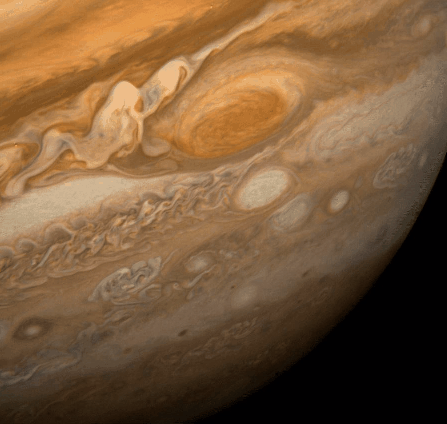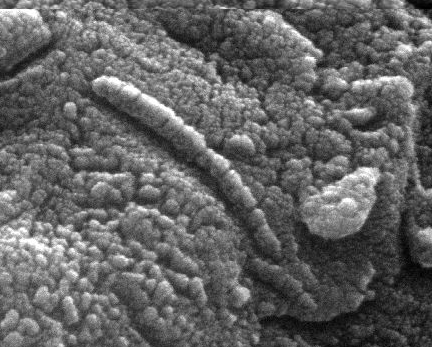NASA APOD #409-417
#409 Tomorrow's picture: August 01, 1996
“You are flying through space and come to ... the Hydra Cluster of Galaxies. Listed as Abell 1060, the Hydra Cluster contains well over 100 bright galaxies. Clusters of galaxies are the largest gravitationally-bound objects in the universe. All of the bright extended images in the above picture are galaxies in the Hydra Cluster with the exception of unrelated diffraction crosses centered on bright stars. Several proximate clusters and galaxy groups might together create an even larger entity - a supercluster - but these clumps of matter are not (yet) falling toward each other. In fact, the Hydra cluster is thought to be part of the Hydra-Centaurus Supercluster of galaxies. Similarly, our own Milky Way Galaxy is part of the Local Group of Galaxies which is part of the Virgo Supercluster of Galaxies."
Copyright: STScIAAO
#410 Tomorrow's picture: August 02, 1996
“Imagine a hurricane that lasted for 300 years! Jupiter's Great Red Spot indeed seems to be a giant hurricane-like storm system rotating with the Jovian clouds. Observed in 1655 by Italian-French astronomer Jean-Dominique Cassini it is seen here over 300 years later - still going strong - in a mosaic of recent Galileo spacecraft images. The Great Red Spot is a cold, high pressure area 2-3 times wider than planet Earth. Its outer edge rotates in a counter clockwise direction about once every six days. Jupiter's own rapid rotation period is a brief 10 hours. The Solar System's largest gas giant planet, it is presently well placed for evening viewing. (APOD thanks to Alan Radecki for assembling a preliminary mosaic from the Galileo imagery!)"
Copyright: Public domain
#411 Tomorrow's picture: August 03, 1996
“What makes the colors in Jupiter's clouds? With a mean temperature of 120 degrees Kelvin (-153 degrees Celsius) and a composition dominated by Hydrogen (about 90%), and Helium (about 10%) with a smattering of hydrogen compounds like methane and ammonia, astronomers have been hard pressed to explain the blue, orange and brown cloud bands and the salmon colored "red" spot. Trouble is -- at the cool cloud temperatures Jupiter's atmospheric constituents should be colorless! Some suggest that more colorful hydrogen compounds well up from warmer regions in the atmosphere, tinting the cloud tops. Alternatively, compounds of trace elements like sulfur may color the clouds. The colors do indicate the clouds' altitudes, blue is lowest through red as highest. The dark colored bands are called belts and the light colored ones zones. In addition to the belts and zones, the Voyager missions revealed the presence of intricate vortices visible, for example, in this 1979 image from the Voyager I flyby. Centuries of visual observations of Jupiter have revealed that the colors of its clouds are ever changing."
Copyright: Public domain
#412 Tomorrow's picture: August 04, 1996
“A bird? A plane? No, but pictured here is something physically much larger, flying much higher, and moving much faster than either of these. It is, in fact, a Seyfert type 2 spiral galaxy. The "S" is actually a lane of stars, gas and dust circling the core. Designated NGC 3393, the bright core makes this galaxy a Seyfert and the infrared glow of central dust help distinguish it as "type 2." Seyfert galaxies have extremely energetic nuclei similar to more powerful quasars. Seyferts are thought to have black holes in their centers. Most of the lines and small spots in this image are due to cosmic rays striking the imager and are unrelated to structure in the galaxy."
Copyright: Public domain
#413 Tomorrow's picture: August 05, 1996
“Jupiter's moon Io has active volcanoes. The Voyager spacecraft caught several erupting when they passed the energetic moon in 1979. In the above picture, several of Io's volcanoes are visible and one is seen actually erupting. Debris from this explosive event can be seen on the upper left of the photo, just beyond Io's edge. Io's volcanism is thought to be caused by the large tidal distortions raised by Jupiter, Europa, and Ganymede. These tides stretch Io, cause internal friction, and thus heat the interior. The hot interior then expands and forces its way out through volcanoes. Currently, the spacecraft Galileo is orbiting Jupiter and photographing Jupiter's Galilean moons."
Copyright: Public domain
#414 Late News: August 06, 1996
“Is there life beneath Europa's frozen surface? Some believe the oceans found there of carbon-enriched water are the best chance for life, outside the Earth, in our Solar System. Europa, the fourth largest moon of Jupiter, was recently discovered to have a thin oxygen atmosphere by scientists using the Hubble Space Telescope. Although Earth's atmospheric abundance of oxygen is indicative of life, astronomers speculate that Europa's oxygen arises purely from physical processes. But what an interesting coincidence! The above picture was taken by a Voyager spacecraft in 1979, but the spacecraft Galileo is currently circling Jupiter and has been photographing Europa. The first of these pictures will be released two days from today. Will they show the unexpected? Late News: NASA to Release New Europa and Jupiter Pictures Thursday More Late News: New Evidence Suggests Microscopic Life Existed on Mars"
Copyright: Public domain
#415 Tomorrow's picture: August 07, 1996
“Today a team of NASA and Stanford scientists announced the discovery of strong circumstantial evidence that microscopic life once existed on Mars. Dr. David McKay, Dr. Everett Gibson, and Kathie Thomas-Keprta of Lockheed-Martin, all from (NASA /JSC), and Dr. Richard Zare (Stanford) have led a team that has found chemical evidence for past life on Mars - including what they interpret as possible microscopic fossil remains (tube-like structures pictured above) - in a meteorite thought to have originated on Mars. A small fraction of the many meteorites that fall to Earth from space have composition similar to the Martian surface. Many scientists believe that these meteorites are indeed Martian rocks that have been catapulted into space during a catastrophic event on Mars, such as an asteroid impact. The escaped rocks would then circle the inner Solar System, some of them falling to Earth. The meteorite containing the evidence landed on Earth 13,000 years ago, but may indicate a life-form that existed on Mars billions of years ago. The team's findings will be published in the August 16 issue of Science Magazine. Even skeptical scientists look forward to future research confirming or refuting these exciting claims."
Copyright: Public domain
#416 Tomorrow's picture: August 08, 1996
“Alien! Alien? Is this what an ancient Martian looked like? The tube-like form on the above highly magnified image is now believed by many to be a fossil of a simple Martian organism that lived over 3.6 billion years ago. If this extraordinary claim is true, this alien could hardly have been less intimidating as its fossil measures less than 1/100th the width of a human hair. A reconstruction of events indicates that the meteorite that housed this potential fossil was catapulted from Mars during a huge impact 16 million years ago and fell to Earth's Antarctica only 13,000 years ago. Evidence supporting this claim of early Martian life includes organic molecules and mineral features characteristic of biological activity found in the meteorite. NASA missions to Mars in the next few years include Mars Global Surveyor and Mars Pathfinder, which may uncover data that help confirm or refute this exciting claim."
Copyright: Public domain
#417 Tomorrow's picture: August 09, 1996
“From a radiant point in the constellation of Perseus, Comet Swift-Tuttle presents -- The Perseid Meteor Shower -- coming to your night sky this weekend! A bookish E. C. Herrick of New Haven, Connecticut correctly suspected in 1837 that this meteor shower was an annual event. Indeed it is now known to be a regular August shower caused by the yearly passage of the Earth through the orbiting debri left behind by periodic comet Swift-Tuttle. Since the bits of comet debri are moving along parallel orbits, on entering the atmosphere they leave fiery trails which appear to originate from a common radiant point in the sky, in this case in the constellation of Perseus. Dramatically illustrated in this composite video image made using MOVIE, meteors from the 1994 Perseids streak across the sky framed by the three bright stars of the asterism known as the "Summer Triangle". The image shows bright Perseids recorded that year from August 9 through 14. Here the trails appear nearly parallel as the camera was centered on the sky about 90 degrees from the radiant point. This year, European and North American observers should be able to view the shower near its maximum, about 90 meteors per hour, early Monday morning August 12, but the shower should be enjoyable on clear weekend nights (August 10,11) as well. After midnight is generally the best time for viewing. What's the best way to enjoy a meteor shower? Get a warm jacket and a comfortable lawnchair ... go outside and look up."
Copyright: Public domain
Upvote! Resteem! Comment! As you like it! Thank you for attention!








